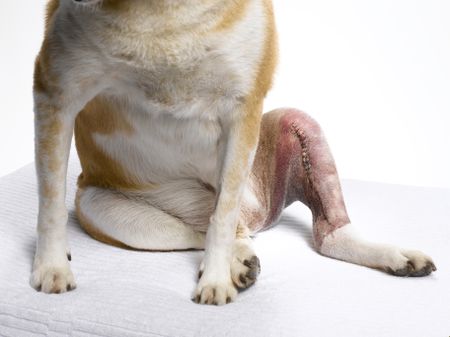A ruptured cranial cruciate ligament is the most common knee injury in our pet dogs. Larger breed dogs, particularly Labrador retrievers, Golden retrievers, Rottweilers, Neoplitan mastiff, Newfoundlands, Staffordshire Terriers and Labradoodles seem particularly prone.
The history is usually a sudden onset of rear leg limping. With acute, complete tears of the cruciate ligament, your dog will be so sore that he will hardly put any weight on the affected leg. For some dogs, a CCL tear occurs over a longer period of time in which they first experience only a partial tear of their ligament. This may show itself as limping on the hindlimb that seems to improve only to reappear a short while later. Most dogs with partial tears usually go on to fully tear their CCL ligament in the not so distant future.
The diagnosis of a CCL tear is made by palpating the knee and finding what is called a drawer sign. A drawer sign is an excess forward mobility of the tibia in relation to the femur. This does not happen with an intact cranial cruciate ligament.
Although a diagnosis of a cruciate ligament tear is made by palpation, an x ray of the knee is recommended to ensure that other bone disease such as cancer or infection did not lead to the rupture. An x ray will also show how much arthritis is already affecting the knee.
Rest and pain medication are the starting points of care for your dog diagnosed with a CCL tear. Laser therapy, joint supplements such as glucosamine, and cartrophen injections are also beneficial for joint healing. However, for most dogs, especially large breed dogs, these alone will not be enough to regain pain free, normal mobility.
Without an intact cruciate ligament, the knee is unstable. This leads to abnormal wear and tear between the bones and the cartilage and the knee begins to develop arthritis. Arthritic changes can be seen as soon as 1 to 3 weeks after an injury and worsens with time. This leads to chronic pain and loss of joint motion.
Large breed dogs carry more weight on their joints and are particularly affected by arthritis. For this reason, surgery is the treatment of choice for all large breed dogs. A portion of smaller dogs, typically those that are less than 10 kg, can recover without surgery.
A TPLO (tibial plateau leveling osteotomy) surgery is what our local veterinary surgical specialists recommend as the best surgical option for CCL tears. This is a surgical procedure in which the tibia is cut and repositioned in such a way that the natural weight bearing of the dog actually stabilizes the knee joint. The surgery is technically precise, requires specialized equipment and advanced training. At Amherst Veterinary Hospital, we recommend that this surgery be performed by a boarded veterinary surgeon.
View of a dog’s stifle after TPLO surgery.
Recovery from the surgery generally takes 3 months and your dog should back to his normal active self by 4 months.
If you suspect that your dog has ruptured his cruciate ligament or wish to discuss treatment options, the veterinarians at Amherst Veterinary Hospital would be happy to meet with you and your dog to provide further information.
Dr. Loretta Yuen D.V.M



